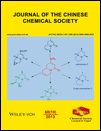Journal list menu
Export Citations
Download PDFs
Cover Picture
Cover Picture: Journal of the Chinese Chemical Society 10/2013
- First Published: 07 October 2013

The cover picture shows that a sulfur-substituted 4-quinolizidinone, previously prepared by an aza-Diels-Alder reaction and ring-closing metathesis, has now been used to complete the formal synthesis of cermizine C and 5-epi-cermizine C, and for other useful synthetic transformations. More discussions are presented in the article by Prof. Shang-Shing P. Chouet al. on page 1260–1266.
Contents
Contents: Journal of the Chinese Chemical Society 10/2013
- Pages: 1187-1191
- First Published: 07 October 2013
Communication
CuO-CeO2 Nanocomposite: A Highly Efficient Recyclable Catalyst for the Green Synthesis of 1,8-Dioxooctahydroxanthenes in Water
- Pages: 1193-1196
- First Published: 11 July 2013

This article describes the applicability of CuO-CeO2 nanocomposite as a green, and efficient basic recyclable catalyst for the synthesis of 1,8-dioxo-octahydroxanthene in water. The main advantages of this method are: Introduction of a new catalyst for the promotion of the synthesis of very important biologically active compounds (xanthene derivatives), short reaction times, high yields of the products, easy and clean work-up procedures.
An Environmental Friendly Approach for the Synthesis of Spiro[indoline-3′,2-quinazoline]2′,4(3H)-dione Using 1-Methylimidazolium Hydrogen Sulfate, as Reusable Catalyst
- Pages: 1197-1201
- First Published: 22 July 2013
Articles
One-pot, Green and Efficient Synthesis of 3,4-Dihydropyrimidin-2(1H)-ones or Thiones Catalyzed by Citric Acid
- Pages: 1202-1206
- First Published: 11 July 2013
Breakdown of Born-Oppenheimer Approximation as a Physical Mechanism for Ultrafast Hydrogen Migrations in Strong Laser Driven Molecules
- Pages: 1207-1211
- First Published: 11 July 2013

(a) In first half cycle, one electron ionizes, yielding a proton p and the donor D. (b) During second half cycle, another electron ionizes and D becomes positively charged and expels p towards the acceptor A. (c) Interplay of the p-A interaction V and the field F. (d) The (Ap)+ ion is formed and subsequently dissociates from the D+ ion.
Virtual Screening: Using Molecular Docking and 3D-QSAR Analysis of Matrix Metalloproteinase Inhibitors
- Pages: 1212-1224
- First Published: 03 July 2013
Effects of Divalent Metal Ions on the Chaperone Activity and Structure of Rat Lens H18G Mutant αB-Crystallin
- Pages: 1225-1233
- First Published: 03 July 2013

This work showed that Zn2+ and Cu2+ ions significantly enhance the chaperone-like activity of wild type rat lens αB-crystallin up to 9.64% and 35.14%, respectively, and also induces the dissociation and re-association of the aggregates into a high molecular weight aggregates with molecular weights higher than 1400 kDa and then precipitates. These results may suggest that in an in vivo lens, Zn2+ and Cu2+ ions could bind with α-crystallin to form a stable complex that enhances its chaperone-like activity; while in a way, it could be a key factor leading to the formation of cataracts.
Evaluation of Antimicrobial Activity of Some Newly Synthesized 4-Thiazolidinones
- Pages: 1234-1240
- First Published: 22 July 2013

The antibacterial activity of 13 novel 4-thiazolidinone (4-TZONs) and four dithiolane derivatives was assessed against bacterial species including MRSA. The activity of 4-TZONs depends mainly on the presence of specific groups (C5-p-choropheny and C2 dicarboxyethyl). No characteristic fungal activity was observed; however, some C5-p-nitro thiazolidin-4-ones displayed synergestic effect with a few commercial antiobiotics.
Chemiluminescence of Colloidal MnO2 with Luminol and Determination of Polyhydroxyl Compounds
- Pages: 1241-1245
- First Published: 26 June 2013

The dicopper(II) complex [Cu2L2](ClO4)4 L = 2,2′-bipyridyl-6,6′-bis(2-acetylpyrazinohydrazone) was synthesized and the structure of dicopper double-helicate was confirmed by X-ray diffractometry. The self-assembling process was studied by UV-Vis spectrometric titration experiments which revealed the formation of dinuclear complexes [Cu2L2](ClO4)4. Variable-temperature magnetic measurements reveal weak antiferromagnetic interactions between Cu(II) ion centers with J = -0.63 cm−1.
Automated Sequential-injection Chemiluminescence Determination of Glucosamine Sulphate via Luminol-Hydrogen Peroxide System
- Pages: 1246-1252
- First Published: 22 July 2013
Electrocatalytic Reduction of Metronidazole on Bismuth Modified Pencil-lead Electrode
- Pages: 1253-1259
- First Published: 11 July 2013

A new modified pencil-lead electrode with bismuth thin film was reported based on an experimental design method for the preparation of modified electrode. On the prepared modified electrode, the electrocatalytic behaviour of metronidazole was exploited. This work introduces a sensitive detection system for the mercury-free reduction and determination of metronidazole in pharmaceutical and biological samples by using differential pulse voltammetry and amperometry methods.
Synthetic Transformations of Sulfur-Substituted 4-Quinolizidinones
- Pages: 1260-1266
- First Published: 26 July 2013
Fast and Efficient Reductive Amination of Aldehydes by NaBH4/B(OH)3 and NaBH4/Al(OH)3
- Pages: 1267-1271
- First Published: 11 July 2013
N-Nitrosation of Secondary Amines Using Supported Perchloric Acid on Silica Gel and Stereoselectivity Study of Nitrosated Products
- Pages: 1272-1276
- First Published: 11 July 2013
Separation of Lipids on Human Very Low-density Lipoproteins by Micellar Electrokinetic Chromatography
- Pages: 1277-1284
- First Published: 03 July 2013

Liquid-phase and solid-phase extractions in combination with a simple micellar electrokinetic chromatography method were used to investigate human very low-density lipoprotein lipids for two healthy donors. At absorbance 200 nm, a major peak and several minor peaks appeared for the total lipids of native VLDL, but both the peak numbers and areas reduced for the in vitro oxidized VLDL.
Electrochemical Oxidative Detection of Guanosine-5′-triphosphate Based on a New Ionic Liquid Modified Carbon Paste Electrode
- Pages: 1285-1290
- First Published: 03 July 2013

A new ionic liquid 1-(3-chloro-2-hydroxy-propyl)-3-methylimidazolium trifluoroacetate was used as the modifier for the preparation of the carbon paste electrode (CPE), which showed excellent electrocatalytic activity towards the oxidation of guanosine-5′-triphosphate (5′-GTP). Electrochemical parameters of 5′-GTP on IL-CPE were calculated and a sensitive differential pulse voltammetric method for the detection of 5′-GTP was proposed.





![An Environmental Friendly Approach for the Synthesis of Spiro[indoline-3′,2-quinazoline]2′,4(3H)-dione Using 1-Methylimidazolium Hydrogen Sulfate, as Reusable Catalyst](/cms/asset/bd3a71f6-f39a-4915-a805-017c9f80207a/mcontent.jpg)






